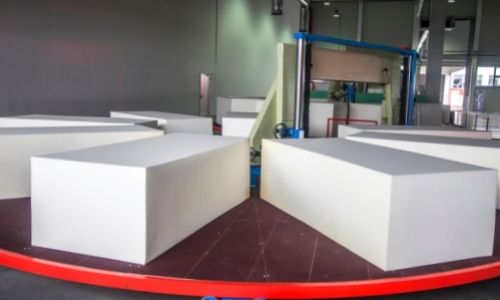Nowadays, mattresses are made using various layers of foam materials such as memory foam, latex, poly-foam, and more.
Even in these foam materials, you will find tons of variations in terms of firmness and density. Foam density plays a crucial role in the feel and performance of the mattress.
In this article, we will discuss various densities of foam and how they make a difference and mention what foam density mattress is suitable for different sleepers.
What is Foam Density?
Mattress foam density is the mass of one cubic foot of the layer of memory foam, and it is expressed in pounds. A five-pound foam mattress can be determined as a 12”x 12”x 12” cube of foam that would weigh around five pounds.
A mattress layer that has high density will be much heavier and make you feel more solid than a mattress with low density. The density level of the memory foam plays a major role in providing support and durability.
Memory foam density isn’t related to the firmness or thickness of the mattress.
3 Types of Foam Density
Mattress foam density comes in three forms: low-density, high-density, and ultra-high-density.
| Foam Density | Quality | Durability | Cost |
|---|---|---|---|
| Low Density (3 lb or less) | Low | Low | Very Low |
| High Density (3.5 to 5 lb) | Very Good | Very Good | High |
| Ultra-High Density (5 lb to 10 lb) | Excellent | Excellent | High |
1. Low-Density Foam
Low-density foam mattresses usually measure at 3lb/ft³, or they can be lower. Such mattresses make your body sink through the mattress top layer as they soften quickly.
A low-density foam mattress has better airflow and temperature control. Another excellent quality of low-density foam is that they are much more affordable than high and ultra-high-density foam mattresses.
Due to the lower price point of low-density foam, brands tend to use this level of density. However, low density indicates less durability, shorter lifespan, and low support compared to mattresses with higher-density foam.
2. High-Density Foam
High-density foams come in the range of 3.5 lb/ft³ to 5 lb/ft³. It provides an ideal mix of support and durability along with a fair price point.
High-density mattresses can be great for people who suffer from shoulder, back, or hip pain as these mattresses contour your body shape and help provide better support.
Higher-density foams provide a much larger life span for mattresses compared to low-density foam.
3. Ultra High-Density
Ultra high-density comes under the range of 5 lb/ft³ to 10 lb/ft³. These high-density mattresses provide you with a high lifespan and inadequate airflow through the material.
The regular mattress manufacturers do not commonly make these kinds of mattresses with ultra-high-density as they contain a hefty price tag and aren’t really suited for those who prefer to sleep hot.
However, these ultra-high-density mattresses do provide excellent support to pressure points.
How Foam Density Affects Mattress Performance
Here are the factors that are affected based on the foam density of the mattress:
1. Durability
Foams that are denser provide more durability, and they also tend to outlast low-density materials. They are less susceptible to the sagging and are also more resistant to incidental damages.
2. Weight of the Mattress
Density foam does play a massive role in the weight of the mattress. The higher the density, the more the weight of the mattress will be a bed that has low-density foam will typically weigh around fifty to sixty pounds.
In comparison, a mattress with higher density foam may weigh around 90 pounds or even more.
3. Pressure Relief
A mattress with high-density foam is better for dealing with body pressure relief. High-density foams build up less pressure in areas like your shoulders and back by molding closer to the body while sleeping. They conform closer than foams with lower density.
4. Temperature Neutrality
Mattresses with low density are more likely to perform better in temperature neutrality as they provide better airflow, and they also don’t tend to absorb as much body heat as a mattress with high density.
Different Densities for Different Sleepers
We all have different preferences and issues, even when it comes to mattresses. Some minds suffer from back pain issues, and some might be heavier sleepers. Therefore, different kinds of mattresses are available with different densities that can help provide the sleeper with the comfort they need.
Different types of densities for different sleepers are as follows:
Side Sleepers
High-density mattresses are considered best for side sleepers as it helps provide an ideal pressure point relief around the shoulders and hips as side sleepers are likely to dig in deeper into their mattress.
Back Sleepers
People who are back sleepers tend to spread weight all across their mattress, due to which they tend to provide more flexibility in density.
High and Ultra high-density mattresses are considered the best mattresses in india because the Ultra high-density mattresses can help deliver back sleepers with better spinal support than a low-density mattress.
Stomach Sleepers
People who sleep on their stomachs should go for high and ultra-high-density mattresses as they can help maintain their spinal integrity.
Meanwhile, a low-density mattress can be bad for stomach sleepers as their back usually runs the risk of arching inward over a period of time because of less support.
Sleepers with body pain or aches
Sleepers who are suffering from body aches or other pain should choose either high or ultra-high-density mattresses as they help provide unparalleled support to your critical areas. Also, it helps maintain a proper alignment when your sleep.
Density mattress based on your BMI
Knowing your BMI (body mass index) can be helpful for you in deciding which mattress density will be most suitable for you. BMI is basically a number based on your weight and height, which can be found using an online calculator.
Lightweight sleepers
A low-density mattress can work for people who have a BMI score under 20 as this mattress material will be under less stress. High-density mattresses will provide lightweight sleepers with the same level of comfort. Also, high-density mattresses are more capable of handling changes in lifestyle.
Medium-weight sleepers
High-density mattresses are most suitable for people with a BMI of 20 to 30 as they can provide the ideal balance between durability and comfort. These high-density mattresses might be more priced than those with lower-density, but they are great for your body support in key areas.
Heavier Sleepers
High or Ultra high-density mattresses are the best options for people with a BMI of 30 and above as these mattresses will help keep their integrity over the period of time. Also, high or ultra-high mattresses will also help provide good support and comfort to the sleeper.
Firmness and Density of Mattress
The density foam used in a mattress and the firmness of the mattress are often considered the same thing. However, they aren’t exactly the same.
The complete composition of the mattress decides the firmness level of a mattress. In comparison, the density is determined based on the individual components of the mattress.
The distinct layer, including support cores, comfort layers, and even the metal springs involved, plays a role in how a mattress feels.
A mattress might use low-density foam on the top, still feel overall like a firm mattress. Conversely, a mattress with high-density support cores can still be completely soft.
FAQs
Do high and low-density memory foam mattresses sleep hot?
No, high and low-density memory foam mattresses have excellent airflow. It contains an open cell that helps improve breathability and a beaded gel that assists in improving heat dissipation.
Is a memory foam mattress suitable for people with allergies?
Yes, memory foam mattresses are suitable for people with allergies as memory foam mattresses use components that promote good health as they are dust mite resistant and hypoallergenic, so people suffering from any allergy or respiratory problems feel safe.
Conclusion
Foam density plays a significant role in determining the performance of the mattress. Also, the different densities of foam help provide comfort to sleepers with different preferences and concerns such as back pain, shoulder pain, and more.
Therefore, foam densities do create a lot of difference in the presentation of the mattress. We hope that all your doubts about foam density are cleared through this article.
If you have any further questions about foam density, then let us know in the comments.







